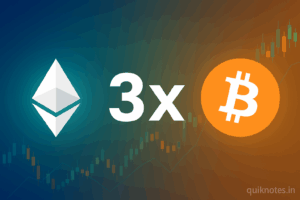Summary:
According to a recent Glassnode analysis, long-term Ethereum (ETH) holders are moving and selling their coins three times faster than their Bitcoin (BTC) counterparts. The data underscores a growing narrative: Ethereum acts as a “digital oil” to power decentralized applications, while Bitcoin increasingly resembles a “digital savings” asset.
What the Report Shows
- Higher ETH Turnover: Glassnode’s data reveals that ETH long-term holders mobilize dormant coins at approximately 3× the rate of BTC long-term holders.
- Roles Diverge: The report frames the divergence by describing BTC as a store-of-value asset (akin to digital gold), with low turnover and increased accumulation into long-term holdings.
- ETH as Utility Fuel: By contrast, Ethereum’s higher mobility is tied to its role in DeFi, smart contracts, gas fees, staking, and other on-chain utilities.
- Locked ETH Supply: About 25% of Ethereum’s supply is currently locked in staking or ETFs, according to the same data.
- Velocity Metrics: The report also highlights Ethereum’s daily turnover rate is around 1.3%, compared to Bitcoin’s 0.61%, signaling more active movement on the ETH side.
- Changing Exchange Balances: Glassnode and Keyrock also point out that balances on exchanges are declining — a sign that both BTC and ETH are moving into long-term custody, staking, or investment vehicles.
Why This Matters
- Utility vs. Store-of-Value Narrative: The way ETH is being used — actively circulating, being staked, and fueling decentralized protocols — reinforces its identity not just as an investment, but as infrastructure for DeFi and smart contract ecosystems.
- Long-Term Holder Behavior: That long-term ETH holders are more willing to part with their assets suggests there is a functional economic use case driving movement, rather than speculative transfers alone.
- Structural Implications for BTC: Bitcoin’s low velocity and accumulation into long-term holdings support its role as a “digital savings” vehicle. This could appeal to investors looking for long-term, non-transacting exposure.
- Institutional and On-Chain Growth: As more ETH is locked up in staking and ETFs, it points to increasing institutional adoption and deep on-chain usage — a sign of matured demand patterns.
- Risks & Opportunities: High ETH turnover may reflect vibrant network activity, but it could also create higher liquidity risk or short-term sell pressure. On the other hand, Bitcoin’s accumulation may limit its usable float but also potentially make it more resilient to short-term volatility.
Expert Commentary & Investor Takeaways
- Analysts argue that ETH’s higher turnover confirms the “programmable economy” thesis: holders are not just storing it, they are using it.
- Institutional investors may view BTC as a long-term reserve asset, while leveraging ETH exposure for yield, staking, or active protocol participation.
- Retail participants could interpret this report as a signal that Ethereum remains the backbone of DeFi activity, while Bitcoin continues appealing to long-term value believers.
What to Watch Next
- Changes in staking: Will more ETH be delegated to staking as infrastructure usage grows?
- ETF and custody trends: How will inflows into ETH ETFs evolve, especially given its active use?
- On-chain activity: Will smart contract usage and DeFi growth continue to drive ETH velocity?
- Macro shifts: How do rate changes or liquidity cycles impact the behaviors of BTC and ETH holders differently?
- Monetary evolution: Will the divergence deepen, further solidifying ETH as the utility token and BTC as a digital reserve?
Bottom Line:
Glassnode’s analysis highlights a fundamental shift in holder behavior: Ethereum is being used, not just held, while Bitcoin is increasingly being saved. This split reinforces long-standing narratives about the two assets’ roles in the crypto economy. For investors, these on-chain signals offer a lens into how asset usage — not just price — may drive long-term value.
Also Check: Spot ETF Flows Show Large Outflows for Bitcoin and Ethereum, Inflows for Solana and XRP
